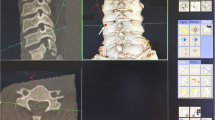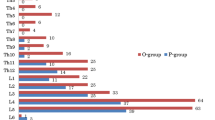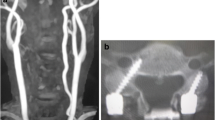Abstract
Purpose
The purpose of this study was to describe a free-hand pedicle screw insertion technique and to evaluate the accuracy of pedicle screw placement and validity of pedicle screw fixation in patients with subaxial cervical spine injuries.
Methods
We retrospectively reviewed 32 consecutive patients with subaxial cervical spine injuries who underwent posterior cervical fixation using our cervical pedicle screw (CPS) insertion technique. We also assessed the clinical and radiological outcomes and the accuracy of pedicle screw placement.
Results
The mean preoperative kyphosis was 4.0°, which was corrected to −5.2° after the operation, and the mean kyphosis angle was −4.4° at the final follow-up. The mean preoperative disc height ratio was 81.9%, and it improved to 105.4% after the operation, which was maintained until the final follow-up measurement of 103.4%. Bony union was achieved, and there were no instrumentation failures in any patient. Overall, 127 pedicle screws were inserted, of which 112 (88.1%) were classified as grade 1 (exact intrapedicular screw positioning), 10 (7.8%) as grade 2 (perforation <50% of the screw diameter), and 5 (3.9%) as grade 3 (perforation more than 50% of the screw diameter).
Conclusion
In our technique, a gutter is created using a high-speed burr at the transitional area between the lateral mass and lamina similar to the procedure in double-door laminoplasty to identify an entry point for CPS insertion. It is easy for general spine surgeons to identify a CPS insertion entry point using our technique.




Similar content being viewed by others
References
Kotani Y, Cunningham BW, Abumi K, McAfee PC (1994) Biomechanical analysis of cervical stabilization systems. An assessment of transpedicular screw fixation in the cervical spine. Spine 19:2529–2539
Jones EL, Heller JG, Silcox DH, Hutton WC (1997) Cervical pedicle screws versus lateral mass screws. Anatomic feasibility and biomechanical comparison. Spine 22:977–982
Karaikovic EE, Daubs MD, Madsen RW, Gaines RW Jr (1997) Morphologic characteristics of human cervical pedicles. Spine 22:493–500
Ludwig SC, Kramer DL, Vaccaro AR, Albert TJ (1999) Transpedicle screw fixation of the cervical spine. Clin Orthop Relat Res 359:77–88
Panjabi MM, Shin EK, Chen NC, Wang JL (2000) Internal morphology of human cervical pedicles. Spine 25:1197–1205
Allen BL Jr, Ferguson RL, Lehmann TR, O’Brien RP (1982) A mechanistic classification of closed, indirect fractures and dislocations of the lower cervical spine. Spine 7:1–27
Jeanneret B, Gebhard JS, Magerl F (1994) Transpedicular screw fixation of articular mass fracture-separation: results of an anatomical study and operative technique. J Spinal Disord 7:222–229
Robertson PA, Ryan MD (1992) Neurological deterioration after reduction of cervical subluxation. Mechanical compression by disc tissue. J Bone Joint Surg Br 74:224–227
Abumi K, Itoh H, Taneichi H, Kaneda K (1994) Transpedicular screw fixation for traumatic lesions of the middle and lower cervical spine: description of the techniques and preliminary report. J Spinal Disord 7:19–28
Abumi K, Kaneda K (1997) Pedicle screw fixation for nontraumatic lesions of the cervical spine. Spine 22:1853–1863
Karaikovic EE, Kunakornsawat S, Daubs MD, Madsen TW, Gaines RW Jr (2000) Surgical anatomy of the cervical pedicles: landmarks for posterior cervical pedicle entrance localization. J Spinal Disord 13:63–72
Ludwig SC, Kramer DL, Balderston RA, Vaccaro AR, Foley KF, Albert TJ (2000) Placement of pedicle screws in the human cadaveric cervical spine: comparative accuracy of three techniques. Spine 25:1655–1667
Rao RD, Marawar SV, Stemper BD, Yoganandan N, Shender BS (2008) Computerized tomographic morphometric analysis of subaxial cervical spine pedicles in young asymptomatic volunteers. J Bone Joint Surg Am 90:1914–1921
Zheng X, Chaudhari R, Wu C, Mehbod AA, Transfeldt EE (2010) Subaxial cervical pedicle screw insertion with newly defined entry point and trajectory: accuracy evaluation in cadavers. Eur Spine J 19:105–112
Karaikovic EE, Yingsakmongkol W, Gaines RW Jr (2001) Accuracy of cervical pedicle screw placement using the funnel technique. Spine 26:2456–2462
Miller RM, Ebraheim NA, Xu R, Yeasting RA (1996) Anatomic consideration of transpedicular screw placement in the cervical spine. An analysis of two approaches. Spine 21:2317–2322
Abumi K, Shono Y, Ito M, Taneichi H, Kotani Y, Kaneda K (2000) Complications of pedicle screw fixation in reconstructive surgery of the cervical spine. Spine 25:962–969
Kotani Y, Abumi K, Ito M, Minami A (2003) Improved accuracy of computer-assisted cervical pedicle screw insertion. J Neurosurg 99(Suppl 3):257–263
Richter M, Mattes T, Cakir B (2004) Computer-assisted posterior instrumentation of the cervical and cervico-thoracic spine. Eur Spine J 13:50–59
Richter M, Cakir B, Schmidt R (2005) Cervical pedicle screws: conventional versus computer-assisted placement of cannulated screws. Spine 30:2280–2287
Ishikawa Y, Kanemura T, Yoshida G, Ito Z, Muramoto A, Ohno S (2010) Clinical accuracy of three-dimensional fluoroscopy-based computer-assisted cervical pedicle screw placement: a retrospective comparative study of conventional versus computer-assisted cervical pedicle screw placement. J Neurosurg Spine 13:606–611
Ito Y, Sugimoto Y, Tomioka M, Hasegawa Y, Nakago K, Yagata Y (2008) Clinical accuracy of 3D fluoroscopy-assisted cervical pedicle screw insertion. J Neurosurg Spine 9:450–453
Yukawa Y, Kato F, Ito K, Horie Y, Hida T, Nakashima H, Machino M (2009) Placement and complications of cervical pedicle screws in 144 cervical trauma patients using pedicle axis view techniques by fluoroscope. Eur Spine J 18:1293–1299
Miyamoto H, Uno K (2009) Cervical pedicle screw insertion using a computed tomography cutout technique. J Neurosurg Spine 11:681–687
Kowalski JM, Ludwig SC, Hutton WC, Heller JG (2000) Cervical spine pedicle screws: a biomechanical comparison of two insertion techniques. Spine 25:2865–2867
Conflict of interest
None.
Author information
Authors and Affiliations
Corresponding author
Rights and permissions
About this article
Cite this article
Tofuku, K., Koga, H. & Komiya, S. Cervical pedicle screw insertion using a gutter entry point at the transitional area between the lateral mass and lamina. Eur Spine J 21, 353–358 (2012). https://doi.org/10.1007/s00586-011-1969-1
Received:
Revised:
Accepted:
Published:
Issue Date:
DOI: https://doi.org/10.1007/s00586-011-1969-1




